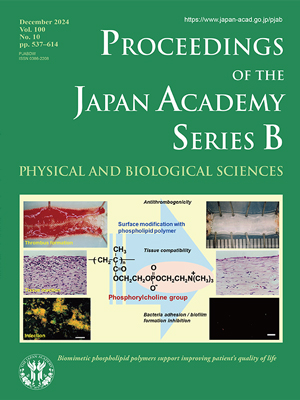About the Cover
Vol. 100 No. 10 (2024)
To support an aging society, address the declining birthrate, and build a vibrant society, developing medical technologies that maintain people’s health and improve treatment efficiency is necessary. Among these, improving the performance of medical devices is important for improving the quality of life (QOL) of patients who have completed treatment and returned to society, quality of life (QOL). Biological reactions, such as blood coagulation and chronic inflammation that occur when they come into contact with a living body, are major challenges for medical devices. Preventing these reactions is necessary owing to the strong demand for biomaterials that can adapt medical devices to living bodies.
Dr. Ishihara (review article in this issue, pp. 579–606) was inspired by the phosphorylcholine group, a polar group of phospholipids at the cell membrane surface, in his biomimetic material design and established the world’s first process for manufacturing 2-methacryloyloxyethyl phosphorylcholine (MPC) as a monomer for introducing this phosphorylcholine group into polymers. MPC polymers with various properties can be obtained via a conventional polymerization process. By treating the material surface with MPC polymer, undesirable biological reactions can be suppressed at the interface between the living body and the material. In other words, protein adsorption is remarkably reduced, and immune cell adhesion and phagocytosis are suppressed. When small-diameter vascular prostheses are fabricated and implanted in animals, they can prevent surface thrombus formation for a long period. MPC polymers are globally recognized as biomaterials that effectively suppress these biological reactions and are used for the surface treatment of implantable medical devices that interact with blood for long periods, such as artificial hearts, coronary artery stents, drug-eluting stents, and stents for treating cerebral aneurysms. Additionally, it has been applied to developing novel contact lens materials. Because it can provide a highly lubricated surface, it suppresses material wear and immune reactions—the biggest challenge in artificial hip joint replacement surgery. Artificial hip joints treated with MPC polymer exhibit long-term therapeutic effects. This series of research—from the molecular design of polymeric biomaterials to the development of industrial manufacturing processes and application to various medical devices to improve QOL—is considered remarkable for unique material research in Japan.
Dr. Kazunari Akiyoshi
Professor Emeritus, Kyoto University




